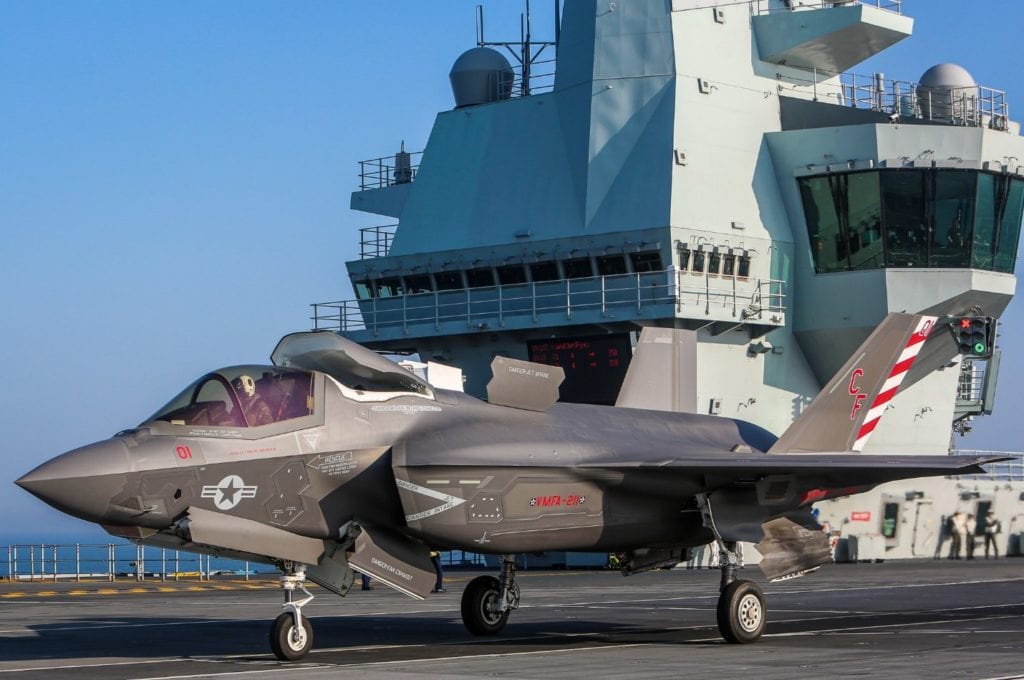Royal Navy Ready to Deploy a Carrier Strike Group for First Time in a Generation

Adm. Anthony David Radakin, First Sea Lord of the Royal Navy, said the upcoming deployment of the HMS Queen Elizabeth (R08) carrier strike group exemplifies the Royal Navy’s commitment to global operations.
Speaking this week at the Surface Warships 2021 conference in London, Radakin said the U.K. continues to demand more from the Royal Navy’s “equipment and people, deploying further, faster and longer to deliver U.K. forward presence around the globe.”
“We, as a nation, have declared ourselves ready to deploy a carrier strike group for the first time in a generation,” Radakin said. “HMS Queen Elizabeth, one of the most advanced and capable aircraft carriers in the world, will deploy at the heart of a multi-national carrier strike group, with Royal Navy and RAF jets and helicopters embarked. She will sail through the Mediterranean, Suez, Indian Ocean and on into the Indo-Pacific, and, on the way, she will exercise with our allies and partners from around the world.”
The U.S. and U.K. defense secretaries made a joint declaration on Jan. 19 regarding the joint participation for the Queen Elizabeth Carrier Strike Group deployment this spring. “The leaders look forward to seeing the culmination of nearly a decade of U.S.-U.K. carrier cooperation when Carrier Strike Group 2021 sets sail from Portsmouth, UK later this year,” the statement said.
The inaugural deployment will include a submarine, destroyers HMS Diamond and HMS Defender, frigates HMS Kent and HMS Richmond, as well as USS The Sullivans (DDG-68) and a frigate from the Royal Netherlands Navy. The strike group will be supported by the Royal Fleet Auxiliary stores ship RFA Fort Victoria and new Tide-class oiler. The airwing will include jet and rotary wing aircraft from the Royal Navy and Royal Air Force, along with F-35B Joint Strike Fighters from U.S. Marine Fighter Attack Squadron 211 (VMFA 211).
VMFA 211 has been operating from Queen Elizabeth and helped the carrier strike group achieve its initial operating capability (IOC) declaration for the carrier strike group earlier this month.
According to a MOD UK statement, the CSG’s IOC means that all elements of the group from fighter jets to radar systems to anti-ship weapons have been successfully brought together and operated.
“Both the air and naval elements of the CSG have now met this milestone, which includes qualified pilots and ground crews being held at short notice for carrier-based operations and trained to handle weapons and maintain the equipment,” the statement said. “Another marker of success at this stage includes the ability to deploy anti-submarine warfare capabilities such as frigates and destroyers, as well as both fixed and rotary wing aircraft including Merlin helicopters to operate alongside the carrier.”
The Queen Elizabeth was commissioned in 2017. With a displacement of 65,000 tons and 920 feet in length, she is the Royal Navy’s largest ship ever. Her sister ship, HMS Prince of Wales (R09), was commissioned two years later.
Radakin said the Royal Navy is taking a larger role in global operations. He pointed to recent deployments of ships like the amphibious assault ship HMS Albion and to the Pacific, and HMS Montrose (F236), which has been deployed in Bahrain, serving with the U.S. Fifth Fleet since April 2019.
“We didn’t just forward base her, she has been available 99 percent of the time, and has the lowest rate of defects of any ship in class,” Radakin said. “The successful Montrose model gives me confidence that we can manage deploying ships, and even start to imagine them never returning to U.K.”